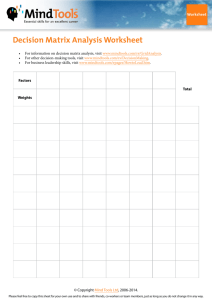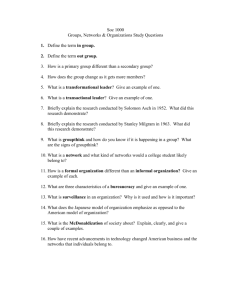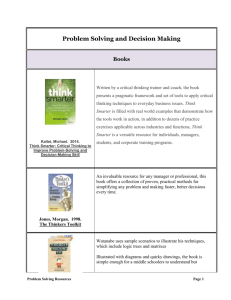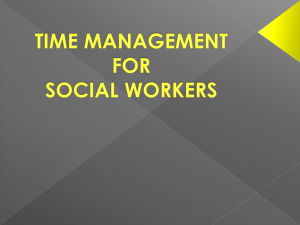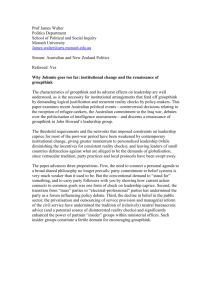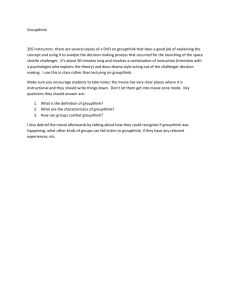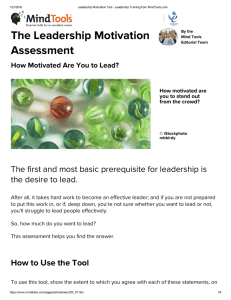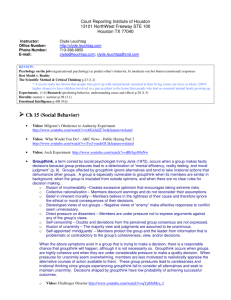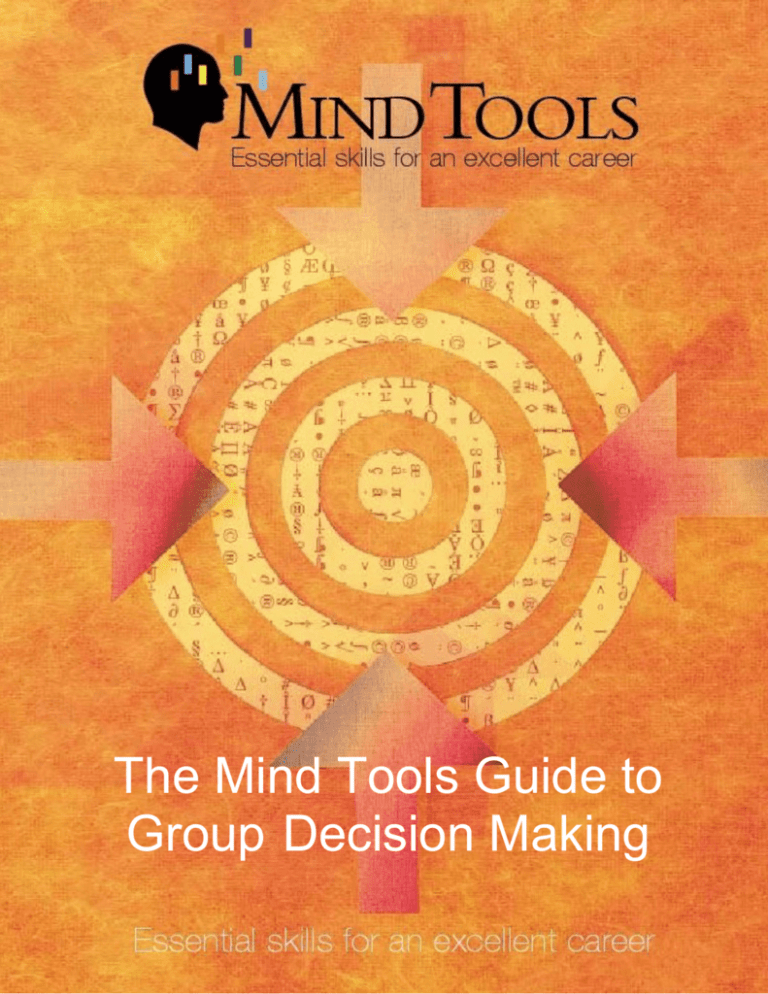
The Mind Tools Guide to
Group Decision Making
The Mind Tools Guide to Group Decision Making
MindTools.com
The Mind Tools Guide to
Group Decision Making
This e-booklet is published by:
Mind Tools Limited
Copyright © Mind Tools 2009. All rights reserved.
Version 1.0
© Mind Tools Ltd, 2009.
2
The Mind Tools Guide to Group Decision Making
MindTools.com
The Mind Tools Guide to
Group Decision Making
Welcome to the Mind Tools Guide to Group Decision Making!
Making a decision is often tough. Is it possible to get all of the data you need? Do you
have “blindspots” when it comes to making decisions in certain areas? When is the right
time to get off the fence and make the decision? And, importantly, who needs to be
involved in making the decision? Just you? Or a group?
When a group needs to make a decision, there are some particular dynamics that come
into play, and some traps to beware of, no matter how good the decision making skills
are of the individual members of the group. That’s why we’ve pulled together all the Mind
Tools articles on group decision making into this handy pdf.
Make sure you’re familiar with these tools and concepts before you next try to take a
decision as a member of a group!
About MindTools
Each year MindTools.com helps more than 6.7 million
visitors from around the world learn the "essential skills for
an excellent career!" Online since 1995, we publish the
practical, proven skills and techniques that help managers
and professionals achieve high personal effectiveness,
become exceptional leaders, become successful… and be
happy at work and in life.
© Mind Tools Ltd, 2009.
3
The Mind Tools Guide to Group Decision Making
MindTools.com
Contents
Organizing Team Decision-Making ................................................................................... 5
Multi-Voting ....................................................................................................................... 8
The Delphi Technique ..................................................................................................... 12
Stepladder Technique ..................................................................................................... 14
Nominal Group Technique .............................................................................................. 15
Avoiding Groupthink........................................................................................................ 17
Next Steps....................................................................................................................... 21
© Mind Tools Ltd, 2009.
4
The Mind Tools Guide to Group Decision Making
MindTools.com
Organizing Team Decision-Making
Reaching consensus for better decisions
While many of the decisions we make on a daily basis are quite simple, some are not.
These decisions may involve assimilating a huge amount of information, exploring many
different ideas, and drawing on many strands of experience. And the consequences of
the right or wrong decision may be profound for the team and the organization.
So, should leaders be decisive, think the issues through on their own, and take firm
action? In some cases, no.
There's a limit to how much information any one individual can process, and a limit on
how many perspectives one person can see. Many decisions need full group
participation to explore the situation, provide input and make a final choice. As you've
probably seen, groups can often make better decisions than any one person operating
on his or her own. This is one of the main reasons that good companies have boards, to
which important decisions are taken.
What's more, many decisions need "buy-in" from the people affected by them if they're to
be implemented successfully, and it's hard to get this buy-in if people haven't been
involved in the decision-making process.
The problem is that when you bring other people into the decision-making process, you
need to approach decisions differently. These approaches vary, depending on a number
of different factors, including:
•
•
•
•
•
The type of decision.
The amount of time and resources available.
The nature of the task being worked on.
The environment the group wants to create.
The amount of buy-in needed.
Understanding why and how best to organize decisions for your team is an important
skill. We'll show you some key tools to use when you want to involve your whole team in
the decision-making process.
The Challenge of Team Decisions
Using team input is challenging, and it takes a fair amount of preparation and time. As
the saying goes, if you put three people together in a room, you'll often get four opinions.
People can often see issues differently - and they all have different experiences, values,
personalities, styles, and needs.
Trying to include all of these differences in one decision that satisfies everyone can be
difficult, to say the least. Team decision-making strategies should therefore be used
when needed, for example, when consensus and participation are necessary.
When time is of the essence, a good decision is one that's made quickly. That doesn't
usually happen with full team decision-making. And when one or two people have the
© Mind Tools Ltd, 2009.
5
The Mind Tools Guide to Group Decision Making
MindTools.com
necessary expertise to make the decision, it doesn't make sense to involve the whole
team - the experts provide most of the input and make the final choice anyway.
However, where the situation is complex, consequences are significant, commitment
and buy-in are important, and where team members can work together maturely, team
decision-making is often best.
Tip:
If the right way forward isn't obvious, see our article on The Vroom-Yetton-Jago
Decision Model. While it's quite complex, it gives you a well-thought-through decision
tree that you can use to work out the approach to use.
Team Consensus Methods
When your whole group needs to be involved in the process, you need to explore
consensus decision-making models. With these, each team member has the opportunity
to provide input and opinions. All members discuss alternatives until they agree on a
solution.
With consensus, there's often compromise. Not everyone gets everything they want out
of the final decision. However, because everyone has fair input, the decisions reached
are often ones that can all live with.
Let's look at a few team decision-making strategies.
•
Ensuring Participation
A consensus decision depends on hearing everyone's opinion. In a team
situation, that doesn't always happen naturally: Assertive people can tend to get
the most attention. Less assertive team members can often feel intimidated and
don't always speak up, particularly when their ideas are very different from the
popular view.
The Stepladder Technique can help manage these differences. Each team
member thinks about the problem individually and, one at a time, introduces new
ideas to the group leader - without knowing what ideas have already been
discussed. After the first two people present their ideas, they discuss them
together. Then the leader adds a third person, who presents his or her ideas
before hearing the previous input. This cycle of presentation and discussion
continues until the whole team has a chance to add their opinions.
The benefit of this process is that everyone feels heard and acknowledged. Once
all the ideas are presented, the team can look at ways to narrow the options
down, and make a decision.
•
Voting for Consensus
Voting is a popular method for making decisions, and it's a good approach to use
where opinions are strongly divided between two or three options.
Unfortunately, it becomes less useful where there are many options - imagine an
election where people have only one vote to choose between eight candidates:
© Mind Tools Ltd, 2009.
6
The Mind Tools Guide to Group Decision Making
MindTools.com
It's possible that a candidate could win with as little as 13% of the vote. This
would leave 87% of people feeling very dissatisfied with the result!
Multi-voting can address this problem. Proceeding through a number of rounds of
voting, individuals are given a certain number of votes in each ballot, which they
can allocate to the various options any way they want. Essentially, they provide a
"weighting" to their choices. They can give one vote to each of several different
choices, all of their votes to once choice, or any combination in between. After all
the votes are placed, the choices with the highest number of votes are carried
through to the next round, until a winner emerges.
This method allows more people to have input in the final decision. There may
still be people who give the final choice no votes, but that number tends to be
significantly reduced. This method is popular when time is an issue and full buyin isn't essential for success.
•
Establishing Group Priorities
A similar situation is where you need to prioritize a set of options, where
everyone has different views, and there's no objective framework that people can
use for decisions. (The classic situation in which this occurs is where people are
allocating resources between competing projects.)
Here, Nominal Group Technique provides an effective framework for ranking
priorities and choosing the option that best fits those priorities. First, the team
discusses the problem, and they narrow down the issues to the key choices they
must evaluate. From there, participants each rank their top choices. The team
totals the rankings for each alternative, and the options with the highest ranking
emerge as the group's priorities.
•
Anonymous Contributions
Sometimes, people with deep expertise that you need to draw on may dislike
one-another so much that they have difficulties working together. In others,
people may need to discuss issues which are real, but unpalatable or
embarrassing. In still others, proposals may need to be developed and explored
in tremendous detail, suiting individual scrutiny and analysis away from a
meeting.
For these situations, managing the process in a way that allows anonymous and
remote contributions can help you avoid destructive situations and reach a good,
well-thought-through decision.
With the Delphi Method, a facilitator helps participants individually brainstorm
solutions and submit their ideas "anonymously" - other team members don't
know who submitted which ideas. The facilitator collects and organizes the input,
submits it to others for development, critique and refinement, then goes back and
forth to all participants until everyone agrees to a final set of choices - and,
eventually, a final decision.
Conducting these discussions is very time-consuming, and you need an
experienced facilitator who can help individuals come together to find a solution.
© Mind Tools Ltd, 2009.
7
The Mind Tools Guide to Group Decision Making
MindTools.com
But the result is usually a robust final decision that has been fully explored, and is
supported by each team member.
The other advantage of the Delphi Method is its ability to eliminate groupthink.
In some situations, group cohesion and consensus can subconsciously
become more important to people than reaching the right decision, with the
result that the group may ignore anything that contradicts the newfound
consensus. If groupthink isn't recognized and corrected, it can lead to very
poor decision-making and severe negative consequences.
Key Points
Team decision-making is often time-consuming, meaning that it makes sense to prepare
for it properly. Before you organize full team participation, make sure that it's
appropriate, and that you have the necessary time and resources for it.
However, teams can often commit more enthusiastically to decisions reached through
consensus. Using a variety of techniques, you can do this in such a way that everyone
has a chance to contribute to the final result.
Multi-Voting
Choosing fairly between many options
Have you ever felt short-changed because of the result of a traditional vote?
The democratic system of majority wins is usually a fair way to make a decision. So long
as voters have sufficient information on which to make a choice, the system usually
works well, just as long as there are only a few options from which to choose.
Do we nominate Mary or Bill as the team representative?
Hands up of those in favor of Mary. 3 hands.
Those in favor of Bill? 12.
Great, Bill it is.
But what happens when the choices expand and each vote is then dispersed over a
wider range? A winner emerges but there are many more people who didn't vote for the
winning option than people who did.
Who should we nominate for employee of the month? Sara, Suzanne, Katherine,
Joseph, or Charles?
Sara gets 3 votes.
Suzanne gets 4.
Katherine gets 3.
Joseph gets 5.
Charles gets 4.
© Mind Tools Ltd, 2009.
8
The Mind Tools Guide to Group Decision Making
MindTools.com
Here, Joseph is nominated by a hair, but only five people feel their opinions were taken
into account. The remaining 14 people have had their choice cast aside like yesterday's
news.
When there are many choices, simple majority rule voting is often not the best method
for reaching decisions, if you want everyone to feel that they own the decision. Yet with
idea sharing and brainstorming activities frequently taking place in workplaces today,
voting is needed more and more. This is particularly the case where the decision is
subjective, where different strong views are held, where many members of the group
have power, or where strong commitment to the outcome is needed.
When group consensus is needed, multivoting is a simple process that helps you whittle
down a large list of options to a manageable number. It works by using several rounds of
voting, in which the list of alternatives becomes shorter and shorter. If you start with 10
alternatives, the top five may move to the second round of voting, and so on.
In addition, in all but the last round, each person has more than one vote, allowing them
to indicate the strength of their support for each option. Everyone votes in each cycle, so
more people are involved in approving the final outcome than if only one vote was held.
Multivoting helps group members narrow down a wide field of options so that the group
decision is focused on the most popular alternatives. This makes reaching consensus
possible, and gives an outcome that people can buy into.
An alternative but slightly more complex group decision making tool is the Nominal
Group Technique. With this, group members nominate options, and are ranked by
group members according to priority.
The key difference between the techniques is that multivoting is easier to understand
(and can therefore seem fairer), while Nominal Group Technique can be used in a
single round rather than several rounds (and is therefore quicker to use.)
How to Use the Tool:
Multi-voting is really very straightforward once you get the general idea. The easiest way
to understand how to conduct a multi-voting session is through an example.
Step 1: Generate options
Henry and his team have a difficult choice to make. Raw material prices for the textile
factory they work in have just gone up significantly, but the company can't raise prices.
Labor costs are going to have to be reduced if the plant is to survive.
He needs to decide how to do this, but he wants to bring his team along with the difficult
decisions that have to be made. After a brainstorming session, his team comes up with a
list that looks like this:
•
•
•
•
Lower production employees' pay scales.
Decrease break time.
Make the lunch period unpaid.
Purchase automated packing equipment and eliminate two full time positions.
© Mind Tools Ltd, 2009.
9
The Mind Tools Guide to Group Decision Making
•
•
•
•
•
•
MindTools.com
Implement a better forecasting model and eliminate overtime.
Reduce benefits such as subsidized child daycare.
Reduce administrative staff.
Outsource machine maintenance.
Outsource housekeeping/janitorial service.
Eliminate the shift supervisor position and pay a "lead-hand" premium instead.
Tip:
Henry has to be confident that the option selected is valid and will deliver the savings
needed – otherwise a weak choice will have the weight of everyone's approval.
He needs either to make sure that all options are good at this stage, or allow
exploration, investigation and debate between voting rounds.
Step 2: Clarify options
Ensure that everyone understands what he or she is voting on.
Step 3: Assign votes per person
A "rule of thumb" is that the number of votes each person gets should be about half the
total number of options. In our example, each of the 11 people voting would be given five
votes, because there are 10 options.
Step 4: First round voting begins
Each person is allowed to allocate his/her votes across the options as he/she sees fit.
Each person can put more than one dot against an option if they want. A common
method is to use sticky dots (or equivalent) and have the participants place a dot, or
dots, beside each option they like.
Tip:
If decisions are contentious, you may want to conduct a secret ballot.
Option
1.
Lower production employees' pay
scales.
2.
Decrease break time.
3.
Make the lunch period unpaid.
4.
Purchase automated packing
equipment and eliminate two full
time positions.
5.
Implement a better forecasting
model and eliminate overtime.
6.
Reduce benefits.
7.
Reduce administrative staff.
© Mind Tools Ltd, 2009.
Votes
z
zzz
zzzzzzzzz
zzzzzzzz
zzz
zzzzz
10
The Mind Tools Guide to Group Decision Making
Option
Votes
8.
Outsource machine maintenance.
9.
Outsource housekeeping/janitorial
service.
zzzzzzzz
zzzzzzz
10. Eliminate the shift supervisor
position and pay a "lead-hand"
premium instead.
MindTools.com
zzzzzzzzzzzz
Tip:
To avoid having people cast all their votes for a single option, you can restrict the
maximum number of votes that people can allocate to each option.
Step 5: Narrow the field
The top 40%-50% of the original list is chosen to move onto the next round of voting. In
our example the top four options are chosen.
•
•
•
•
Purchase automated packing equipment and eliminate two full time positions.
Implement a better forecasting model, and eliminate overtime.
Outsource machine maintenance.
Eliminate the shift supervisor position and pay a "lead-hand" premium instead.
Step 6: Next Rounds of Voting
Repeat steps 3-5, for the next rounds of voting.
In the second round of our example, there are 4 options (40% of the original number of
options) and each person receives 2 votes, and the voting might go like this:
Option
Votes
1. Purchase automated packing
equipment and eliminate two full
time positions
zzz
2. Implement a better forecasting
model and eliminate overtime
3. Outsource machine
maintenance
4. Eliminate the shift supervisor
position and pay a "lead-hand"
premium instead
zzzzz
zzzzzz
zzzzzzzz
The top 2 options will be chosen for the next round, and then each person will have just
a single vote. And so 11 votes, one per team member, will be cast among the 2 favorite
options:
© Mind Tools Ltd, 2009.
11
The Mind Tools Guide to Group Decision Making
Option
Votes
1.
Outsource machine
maintenance
zzzz
2.
Eliminate the shift supervisor
position and pay a "lead-hand"
premium instead
zzzzzzz
MindTools.com
Key Points
In a team setting, where consensus is an appropriate method for making a decision or
narrowing down a field of options, multi-voting is a fair and inclusive process. It respects
the opinions of all participants and allows everyone to be fully involved in the decision. It
works particularly well after a brainstorming session when you have a large number of
options and need to narrow the field to those ideas that are most plausible and realistic.
The Delphi Technique
Achieving well thought-through consensus among experts
It's a common observation to say that when you get three experts together, you'll often
end up with four different opinions. This is particularly the case in areas (such as
resource allocation and forecasting) where the conclusion reached depends on a
number of subjective assessments. Arguments can quickly become passionate, and
disagreement can often become intensely personal and bitter.
More than this, in face-to-face discussion, situations of "groupthink" can occur. Here (for
example) the eccentric views of early or charismatic speakers can achieve undue
prominence as the group seeks to find consensus. This can lead to poor decision
making.
This is where a technique like the Delphi Method is needed to reach a properly thoughtthrough consensus among experts.
How to Use the Tool:
The Delphi Method works through a number of cycles of anonymous written discussion
and argument, managed by a facilitator. Participants in the process do not meet, or even
necessarily know who else is involved: The facilitator controls the process, and manages
the flow and consolidation of information.
The anonymity and remoteness of the process helps to avoid issues of groupthink and
personality conflict. More than this, it gives people time to think issues through properly,
critique arguments rigorously and contribute fully.
The editing of responses by a facilitator means that inflammatory interventions can be
toned down and input can be consolidated efficiently. And the iterative approach means
that arguments can be refined and tested until they are robust and fully-considered.
To use the technique, use the following steps:
© Mind Tools Ltd, 2009.
12
The Mind Tools Guide to Group Decision Making
MindTools.com
• Clearly define the problem to be solved.
• Appoint a facilitator or chairperson with the skills and integrity needed to manage
the process properly and impartially (the rest of this process assumes you are this
person).
• Select a panel of experts with the depth and breadth of knowledge, and proven
good judgment needed for effective analysis of the problem.
• Get individual panel members to brainstorm high level approaches that might be
used to solving the problem.
• Consolidate responses, and iteratively resubmit these to the panel until a stable
and comprehensive list of approaches has been developed.
• Check with the process sponsor that all possible solutions to the problem have
been identified and that no approaches have been missed.
• Work with individual panel members to develop each of the possible solutions to
the problem.
• Consolidate these possible solutions, and send them out to all panel members.
• Panel members then critique solutions, and feed their comments back to the
facilitator.
• The facilitator and panel members refine proposals or, if appropriate, discard them.
• This goes on (iterating back to step 7) until a stable analysis of options has been
conducted and a final conclusion has been reached.
Tip 1:
This is a time consuming technique and a lengthy process, and as such should only
be used for decisions with major consequences. However, techniques like this are
needed for large-scale decisions: Without them there's firstly a real risk that the wrong
decision will be made and, secondly, even good decisions can be undermined with
misplaced criticism.
Tip 2:
As a facilitator, you'll speed the process by setting clear and appropriate deadlines for
feedback. However take care not to give undue weight to early submissions – this is
far too easy to do!
Tip 3:
Beware: The Delphi Technique puts a huge amount of power in the hands of the
facilitator. A crooked or biased facilitator can manipulate the flow of information in
such a way as to reach an outcome that an honest process would not reach.
See http://www.eagleforum.org/educate/1998/nov98/focus.html for a highly-critical but
useful article highlighting how the technique can be abused. Everyone about to
engage in a Delphi exercise should understand the points in this article before the
process starts, so that they can guard against these abuses.
Key Points:
The Delphi Method is a structured approach to problem analysis which makes sure that
problems and proposed solutions are thoroughly explored and examined.
© Mind Tools Ltd, 2009.
13
The Mind Tools Guide to Group Decision Making
MindTools.com
By using a remote and anonymous approach, it avoids the problems of groupthink and
personality conflict that can lead to poor group decision making. More than this, it allows
the time for detailed analysis and careful criticism that so often is not possible within a
group analysis and decision making process.
The process works through a number of cycles of anonymous written discussion and
argument, managed by a facilitator. The facilitator controls the process, and manages
the flow and consolidation of information.
Stepladder Technique
Making better group decisions
Making decisions within a group can often be challenging. When things go well, they can
go very well. However, when things go wrong, you can end up mired in conflict. Some
people may fight for recognition and position, others may be over-critical or disruptive,
while others may sit quietly and not contribute anything to the overall effort. Because of
this, groups can often spin out of control and make worse decisions than individuals
working on their own.
When this happens, it's easy to see why some people throw their hands up in frustration
and give up. However, when a group works in the right way, it really WORKS. Groups
that function effectively together can outperform individuals and make much better
decisions.
But how do you make your group effective? How do you get all the members to
contribute and inspire one another to create great ideas and solutions?
The Stepladder Technique is a useful method for encouraging individual participation in
group decision making.
What is the Stepladder Technique?
The Stepladder Technique is a simple tool that manages how members enter the
decision-making group. Developed by Steven Rogelberg, Janet Barnes-Farrell and
Charles Lowe in 1992, it encourages all members to contribute on an individual level
BEFORE being influenced by anyone else. This results in a wider variety of ideas, it
prevents people from "hiding" within the group, and it helps people avoid being "stepped
on" or overpowered by stronger, louder group members.
All of this helps the group make better decisions.
How to Use the Tool
The Stepladder Technique has five basic steps. Here's how it works.
Step 1: Before getting together as a group, present the task or problem to all members.
Give everyone sufficient time to think about what needs to be done and to form their own
opinions on how to best accomplish the task or solve the problem.
Step 2: Form a core group of two members. Have them discuss the problem.
© Mind Tools Ltd, 2009.
14
The Mind Tools Guide to Group Decision Making
MindTools.com
Step 3: Add a third group member to the core group. The third member presents ideas
to the first two members BEFORE hearing the ideas that have already been discussed.
After all three members have laid out their solutions and ideas, they discuss their options
together.
Step 4: Repeat the same process by adding a fourth member, and so on, to the group.
Allow time for discussion after each additional member has presented his or her ideas.
Step 5: Reach a final decision only after all members have been brought in and
presented their ideas.
The Stepladder Technique is similar to the Delphi Method, another tool that's often
used in groups to prevent Groupthink and to encourage participation. While both tools
have the same objective, they differ in a few key ways:
• In the Delphi Method, an objective facilitator or leader manages the group. In
the Stepladder Technique, all members are equal.
• The Delphi Method keeps members anonymous. The facilitator manages the
flow of information, and members may have no idea who else is in the group.
The Stepladder Technique involves face-to-face meetings, so everyone knows
who the other members are.
• The Delphi Method is a lengthy process, while the Stepladder Technique is
much quicker.
The Delphi Method is often used for major decisions that need input from a large
number of people. The Stepladder Technique works best with smaller groups that
make a wide range of decisions.
Tip:
Many groups can begin to lose their effectiveness and ability to make quality
decisions if they have too many members. Keep your group small – four to six team
members – to maximize effectiveness.
Key Points
The Stepladder Technique is a step-by-step approach to help ensure that all members of
a group participate and are heard. The technique allows shy, quiet people to present
their ideas before other group members can influence them, and it allows everyone to
hear many different viewpoints before reaching a final decision.
Nominal Group Technique
Prioritizing issues and projects to achieve consensus
When a group meets, it's often the case that people who shout loudest, or those with
higher status in the organization, get their ideas heard more than others. So when it
comes to gaining consensus on important decisions or priorities, how do you make sure
you get true consensus and a fair decision for the group?
© Mind Tools Ltd, 2009.
15
The Mind Tools Guide to Group Decision Making
MindTools.com
One technique to help with this is the Nominal Group Technique, a face-to-face group
process technique for gaining consensus. A typical application is in organizational
planning when a group needs to agree priorities in order to assign resources and funds.
The benefit of the technique is that the group shares and discusses all issues before
evaluation, with each group member participating equally in evaluation. The evaluation
works with each participant "nominating" his or her priority issues, and then ranking them
on a scale of, say, 1 to 10.
Nominal Group Technique is just one group process for achieving consensus. Another
group consensus technique is the Delphi Method, which is used among groups of
experts to make complex decisions, usually without face-to-face meetings.
How to Use the Tool:
To use the Nominal Group Technique, use the following steps:
• Select a group leader and group participants. (The rest of the steps assume you
are the group leaders.)
• Present the topic and objectives, usually ahead of the group meeting. Typically the
objective will be to identify issues or projects that are most important to the group
or your organization.
• Ask the group members to discuss the topic, ask questions and seek clarifications.
• Allow participants time to consider the issues and projects they believe are the
most important.
• Ask each participant to write down his or her priority issues or projects. If useful to
do so, ask each group member to read aloud his or her responses, and give time
to explain and elaborate on written responses.
• Record all the group's responses on a master list or a flipchart for the group to
view.
• After all responses have been recorded, work through the responses together as a
group and eliminate duplicates.
• Now ask participants to choose their top priorities: say 5 to 10, depending on the
number of issues and projects that the group needs to agree on.
• Ask each participant to rank these in priority order.
• Collect the group members' rankings and combine these to form a collective
response – this is the group's consensus on the ranking of important issues or
projects.
Example:
In its annual planning meeting, a parents' group must reach consensus on which school
projects to support in the coming year. With limited time and resources, the group must
choose just 5 projects.
The group's planning meeting follows the Nominal Group Techniques process to ensure
a fair selection of priorities. The group members are asked to nominate and rank their 5
top projects. After de-duplicating the group members' responses, there are nine projects
to rank. The highest priority is assigned "5" and the lowest is "1". The ranking grid below
shows the projects that the group submitted and each member's priority ranking. The
final column shows the group consensus on priorities, with the "Family Link" program
being the highest priority.
© Mind Tools Ltd, 2009.
16
The Mind Tools Guide to Group Decision Making
MindTools.com
Tip:
By using the numbered ranking system with "5" high and "1" low, the group
consensus can easily be found by adding up the rank scores of each group member.
The highest priority is simply the highest score.
Group Member
Project
Family Link
program
Literacy program
Community
program
Annual fund
raiser
Summer camp
project
School bus
fund raiser
Book fund
After school
club
Work experience
program
Jay Sue Rik Jina Will Gary "Score"
5
3
2
4
2
3
5
3
19
5 (high)
1
4
4
17
4
5
1
5
1
2
3
5
3
4
1
4
2
9
1
5
10
2
2
2
Group
consensus
priorities
3
1
5
1
8
5
6
4
11
3
Avoiding Groupthink
Avoiding fatal flaws in group decision making
Have you ever thought about speaking up in a meeting or some other type of group
setting and decided against it because you did not want to appear unsupportive of the
group's efforts? Or led a team in which the team members were reluctant to express
their own opinions? If so, you have probably been a victim of "Groupthink".
Groupthink is a phenomenon that occurs when the desire for group consensus overrides
people's common sense desire to present alternatives, critique a position, or express an
unpopular opinion. The desire for group cohesion effectively drives out good decisionmaking and problem solving.
Two well-known examples of Groupthink in action are the Challenger Space Shuttle
disaster and the Bay of Pigs invasion. Engineers of the space shuttle knew about some
faulty parts months before takeoff, but they did not want negative press so they pushed
ahead with the launch anyway. With the Bay of Pigs invasion, President Kennedy made
a decision and the people around him supported it despite their own concerns.
© Mind Tools Ltd, 2009.
17
The Mind Tools Guide to Group Decision Making
MindTools.com
The term "Groupthink" was coined by Irving Janis in 1972 when he was researching why
a team reaches an excellent decision one time, and a disastrous one the next. What he
found was that a lack of conflict or opposing viewpoints led to poor decisions, because
alternatives were not fully analyzed, and therefore groups did not gather enough
information to make an informed decision.
How to spot Groupthink
Janis suggested that Groupthink happens when there is:
• A strong, persuasive group leader.
• A high level of group cohesion.
• Intense pressure from the outside to make a good decision.
In fact, it is now widely recognized that Groupthink-like behavior is found in many
situations and across many types of groups and team settings. So it's important to look
out for the key symptoms, which are listed below:
Symptoms of Groupthink
Rationalization:
This is when team members convince themselves that despite evidence to the contrary,
the decision or alternative being presented is the best one.
"Those other people don't agree with us because they haven't researched the problem
as extensively as we have."
Peer Pressure:
When a team member expresses an opposing opinion or questions the rationale behind
a decision, the rest of the team members work together to pressure or penalize that
person into compliance.
"Well if you really feel that we're making a mistake you can always leave the team."
Complacency:
After a few successes, the group begins to feel like any decision they make is the right
one because there is no disagreement from any source.
"Our track record speaks for itself. We are unstoppable!"
Moral High Ground:
Each member of the group views him or herself as moral: The combination of moral
minds is therefore thought not to be likely to make a poor or immoral decision. When
morality is used as a basis for decision-making, the pressure to conform is even greater
because no individual wants to be perceived as immoral.
"We all know what is right and wrong, and this is definitely right."
Stereotyping:
As the group becomes more uniform in their views, they begin to see outsiders as
possessing a different and inferior set of morals and characteristics from themselves.
These perceived negative characteristics are then used to discredit the opposition.
"Lawyers will find any excuse to argue, even when the facts are clearly against them."
© Mind Tools Ltd, 2009.
18
The Mind Tools Guide to Group Decision Making
MindTools.com
Censorship:
Members censor their opinions in order to conform.
"If everyone else agrees then my thoughts to the contrary must be wrong."
Information that is gathered is censored so that it also conforms to, or supports the
chosen decision or alternative.
"Don't listen to that nonsense, they don't have a clue about what is really going on."
Illusion of Unanimity:
Because no one speaks out, everyone in the group feels the group's decision is
unanimous. This is what feeds the Groupthink and causes it to spiral out of control.
"I see we all agree so it's decided then."
How to Avoid Groupthink
The challenge for any team or group leader is to create a working environment in which
Groupthink is unlikely to happen. It is important also to understand the risks of
Groupthink – if the stakes are high, so must be the effort to ensure good decisionmaking and group outcome.
To avoid Groupthink, it is important to have a process in place for checking the
fundamental assumptions behind important decisions, for validating the decision-making
process, and for evaluating the risks involved. For significant decisions, make sure your
team does the following in their decision-making process:
•
•
•
•
•
•
•
•
•
Explores objectives.
Explores alternatives.
Encourages ideas to be challenged without reprisal.
Examines the risks if the preferred choice is chosen.
Tests assumptions.
If necessary, goes back and re-examines initial alternatives that were rejected.
Gathers relevant information from outside sources.
Processes this information objectively.
Has at least one contingency plan.
There are many group techniques that can help with this, including the "Mind Tools"
listed below. By using one or more of these techniques to accomplish aspects of the
group's work, you will vary the group's ways of working, and so guard against
Groupthink and help make better decisions.
Figure 2: Tools That Help You Avoid Groupthink:
Group Techniques:
Brainstorming
Helps ideas flow freely without criticism.
Nominal Group Technique
Allows each group member to contribute
individually, so mitigating the risk that stronger
and more persuasive group members dominate
the decision making process.
© Mind Tools Ltd, 2009.
19
The Mind Tools Guide to Group Decision Making
MindTools.com
Six Thinking Hats
Helps the team look at a problem from many
different perspectives, allowing people to play
"Devil's Advocate".
The Delphi Technique
Allows team members to contribute individually,
with no knowledge of a group view, and with
little penalty for disagreement.
Decision Support Tools:
Risk Analysis
Helps team members explore and manage risk.
Impact Analysis
Ensures that the consequences of a decision
are thoroughly explored.
The Ladder of Inference
Helps people check and validate the individual
steps of a decision-making process.
How to Overcome Groupthink
However, if Groupthink does set in, it's important that you recognize and acknowledge it
quickly, so that you can overcome it and quickly get back to functioning effectively.
Follow these steps to do this:
• Even with good group decision-making processes in place, be on the look out for
signs of Groupthink, so you can deal with them swiftly.
• If there are signs of Groupthink, discuss these in the group. Once acknowledged,
the group as a whole can consciously free up its decision making.
• Assess the immediate risks of any decision, and the consequences for the group
and its customers. If risks are high (for example risk of personal safety), make sure
you take steps to fully validate any decision before it is ratified.
• If appropriate, seek external validation, get more information from outside, and test
assumptions. Use the bullets above as a starting point in diagnosing things that
needs to change.
• Introduce group techniques and decision-making tools, such as the ones in Figure
2, to avoid Groupthink in the future.
Key Points
Groupthink can severely undermine the value of a group's work and, at its worst, it can
cost people their lives.
On a lesser scale, it can stifle teamwork, and leave all but the most vocal team members
disillusioned and dissatisfied. If you're on a team that makes a decision you don't really
support but feel you can't say or do anything about it, your enthusiasm will quickly fade.
Teams are capable of being much more effective than the individual but, when
Groupthink sets in, the opposite can be true. By creating a healthy group-working
environment, you can help ensure the group makes good decisions and manages any
associated risks.
Group techniques such as Brainstorming, the Nominal Group Technique and Six
Thinking Hats can help with this, as can other decision making and thinking tools.
© Mind Tools Ltd, 2009.
20
The Mind Tools Guide to Group Decision Making
MindTools.com
Next Steps
Explore for more!
For more information on this and other key career skills areas, visit
MindTools.com, and explore the many other free resources available
to you!
Mind Tools offers in excess of 450 management, career and thinking
skills resources, more than 250 of which you can use completely for
free. (The remainder are available to members of our members’ area,
the Career Excellence Club, and are accessible for a first month fee of
just US$1*.)
9
9
9
9
9
9
9
9
9
9
These skill-building articles help you quickly learn the skills you need
to work, lead and manage more effectively; helping you develop a
truly satisfying and successful career!
Leadership Skills
Team Management
Problem Solving
Decision Making
Project
Management
Practical Creativity
Time Management
Stress Management
Information Skills
Communication
Skills
Invest in you – take charge of your life and career for just US$1*!
*US$1 for month 1, then US$19 or US$27/month plus our no-quibble, cancel at any time, money-back guarantee.
The Mind Tools members’ area, the Career Excellence Club gives you
the career training and support you need to make a real success of
your career. It helps you to sharpen your skills and take your wisdom
and abilities to the next level, so that when career opportunities arise,
you'll be the natural choice to take advantage of them!
Within the community forums you’ll join a global network of managers,
professionals, coaches and experts, pleased to help you explore,
understand and resolve the career issues you face. This “on tap”
access to coaching and support makes career development and
personal growth a constant and ongoing part of your life.
9
9
9
9
9
9
9
9
9
Discussion Forums
Coaching Clinic
Self-Study Courses
Skill-Builders
Webinars
Expert Interviews
Book Insights
eClasses
Mentor Network
Join today and get 4
FREE career-enhancing
courses worth US$121!
www.MindTools.com/rs/CXC
You’ll also have access to more than 450 resources, all provided in
our proven, practical, easy-to-apply, tools-based approach, delivered
in bite-sized chunks that suit the way that busy people live and work. Click here to find out more!
Instant accessibility and cost-effective training for organizations
Online training is fast becoming an established part of many organizations’ training strategies, thanks to
the substantial cost savings and efficiency improvements it offers, compared to conventional soft skills
training. MindTools corporate membership provides organization-wide, instant access to the all the
MindTools training resources in one easy-to-own, easy-to manage, cost-effective package.
For more information contact our organization development team on +1 617 379 0748 (US),
+44 208 1445713 (US), corporate.enquiries@mindtools.com, or download our corporate brochure.
Enjoy exploring these skills, and start boosting your career right away!
James Manktelow, CEO, Mindtools.com
© Mind Tools Ltd, 2009.
21

